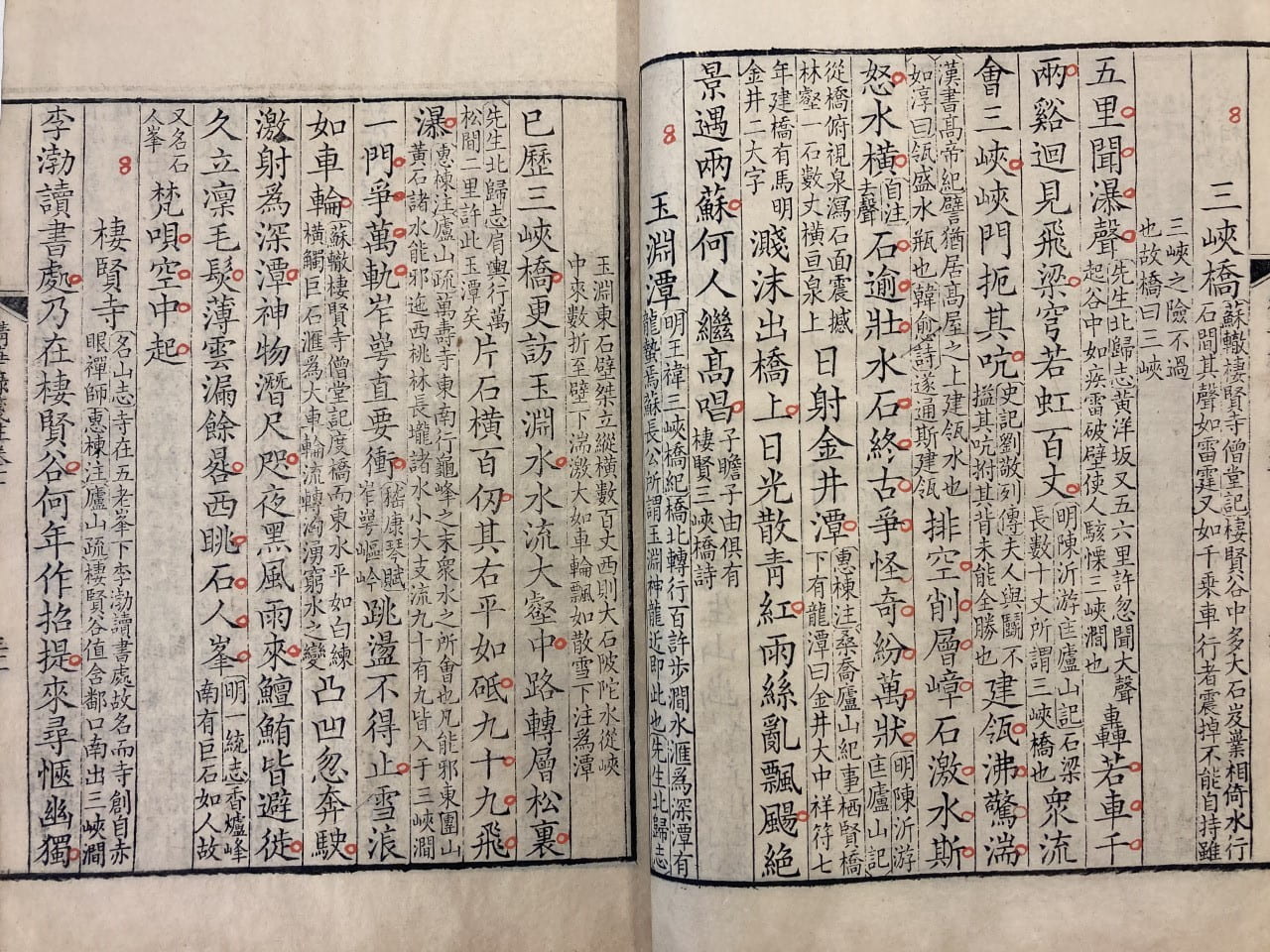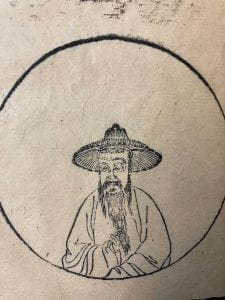
Annotation of selected works of Yuyang Shanren 渔洋山人精华录笺注
The Annotation of selected works of Yuyang Shanren (渔洋山人精华录笺注) in the University of Melbourne’s East Asian Collection was the most widely circulated anthology by early Qing poet Wang Shizhen (王士禛, c.1634-1711). Preferring a reclusive life, Wang authored several anthologies under the pseudonym Yuyang Shanren, or simply Yuyang. In his lifetime, Wang wrote more than 3,000 poems 1. As a leading poet of the Qing Dynasty (1644-1911), these were not only immensely popular, but had a far-reaching impact on the acceptance of Tang Dynasty poetry aesthetics 2. Quite apart from its literary value though, the format of the Annotation provides a fascinating insight into the bitter political struggles of the early Qing Dynasty.
Portrait of Wang Shizhen wearing cone-shaped bamboo hat, The University of Melbourne Collection.
Due to its popularity, many editions of the Annotation circulated, in varying volumes – most commonly 12 juan (scrolls) in either 6, 8, 10 or 12 volumes. Furthermore, among extant editions, some include Wang’s Chronicle (1 juan), Supplement (1 juan), and Appendix (1 juan), which was the compilation of prefaces from Wang’s other anthologies. The University of Melbourne collection has 12 juan in 6 volumes, including the Chronicle and Supplement. Other institutions hold variations on this format: for example Harvard-Yenching Library (HY) holds two copies, one in 8 volumes and the other one in 12 volumes.
Apart from the variance in volume numbers, the differences in content between our copy and the HY copies are noteworthy. The HY 8-volume copy has had all information related to the 17th century literary mogul Qian Qianyi (钱谦益, c. 1582-1664) expunged, including a preface written by Qian, the Appendix in which Wang traced his friendship with Qian, and text in the editorial guide in which Qian is mentioned. The HY 12-volume copy contains Qian’s preface, the Appendix, and retains relevant text in the editorial guide. Our 6-volume copy does not contain Qian’s preface and the Appendix; however, the editorial guide was kept intact.
Left: HY Collection;right: University of Melbourne Collection.
These differences arose due to tensions between the Qing government and Han Chinese literati. Founded by the Manchu people, an ethnic minority, the government was initially keen to engage Han writers and thinkers to help legitimise their rule. When Han Chinese rule collapsed with the Ming Dynasty (1368-1644), many Ming officials loyal to the regime committed suicide. Qian did not though 3. Instead, he served as a high-ranking official in the Qing government in c.1646. For that reason, he was initially disdained by Han intellectuals – and then later by the Qing government as well: the regime inevitably felt the need to advocate the virtue of loyalty once they were firmly established. Qian quit the post five months later, and engaged in anti-Qing campaigns during the last decades of his life. Growing furious at the anti-Qing sentiment in Qian’s literary works, in c.1769 Emperor Qianlong ordered all copies of Qian’s two anthologies in public and private collections to be destroyed, including the wooden blocks they were printed from. Furthermore, Qian’s name was listed in the Erchen Zhuan (贰臣传, Biography of turncoat officials in Ming History). Later, in the process of compiling the Siku Quanshu (四库全书, Complete Library in Four Sections), massive amounts of literature were censored, including an estimated 43 anthologies by Qian; another 72 anthologies by others were indirectly impacted 4.
The Annotation was lucky enough to survive. However, the removal of Qian’s information in extant editions illustrates the damage caused by censorship during the 18th century. Nowadays, we can use this information in conjunction with other evidence to tell the approximate date of different editions. For example, volume 1 in our collection seems to be a reprint of an early edition, which was printed between 1734 and 1784, as information about Qian was retained in the editorial guide. Volumes 2-6 are different from volume 1 in at least three aspects: first, the imprint in volumes 2-6 is clearer and more elegant, whilst volume 1 is slightly blurred; second, like other early prints, volumes 2-6 in our collection have the name of the publisher Fenghui Tang (凤翙堂) in the first page of each juan, whilst volume 1 does not; this means that volume 1 could not be the first print. Finally, the height of volumes 2-6 are the same, whilst volume 1 is shorter and has apparently been conserved post-publication – maybe by a book dealer, in order to sell the works as a complete set. Further study is needed to confirm whether volumes 2-6 are a first print or reprint.
left: volume 1, without the publisher’s name in the first page in each juan; right: volume 2, bears the publisher’s name 凤翙堂 at the bottom left.
Xiaoju Liu,
Curator, East Asian Collection
1. Around c.1700, the Selected works of Yuyang Shanren (渔洋山人精华录), which contains about 1,000 poems in 12 juan, was carved and printed based on the handwriting of Wang’s disciple Lin Ji (林佶), who was well known for his elegant calligraphy. It was later annotated by another disciple, Jin Rong (金荣), and initially printed by Fenghui Tang (凤翙堂, Hall of the flying phoenix), which was owned by Jin. According to the editorial guide, Jin finished the Annotation in c.1734, meaning the first print of the Annotation can be dated no earlier than that.
2. Zhang Limin, “论博学鸿词科对王士禛的诗学影响 [The Influence of Boxuehongci Examination on Wang Shizhen’ Poetics],” Wenxue yichan 4, (2019): 156-164.
3.Qian married the famous courtesan Liu Rushi. According to some miscellaneous notes, when the Ming Dynasty collapsed, Liu urged Qian to commit suicide in loyalty to the Ming Dynasty. But Qin refused, saying that ‘the water was too cold’. Chen Yinke has refuted this narrative in his Liu Rushi Biezhuan (柳如是别传, Anecdotal biography of Liu Rushi), however.
4. Zhuang Jifa, “清高宗禁毁钱谦益著述考,” 清史论集 (三) (Taipei: Wenshizhe chubanshe, 1998), 176, quoted in Li Shuang, “清代《钱注杜诗》暗中流传与突破禁毁考述” (Masters thesis, Capital Normal University, China, 2007], 8. China Doctoral Dissertations/Masters Theses Full-text Database.
Categories
- Uncategorised
- Special Collections



Leave a Reply